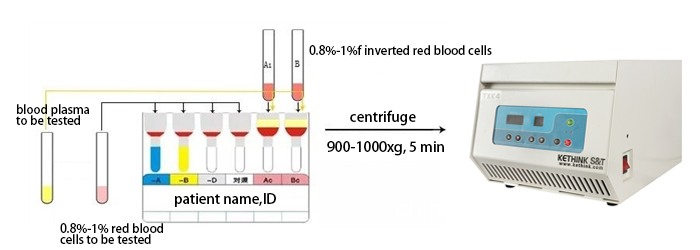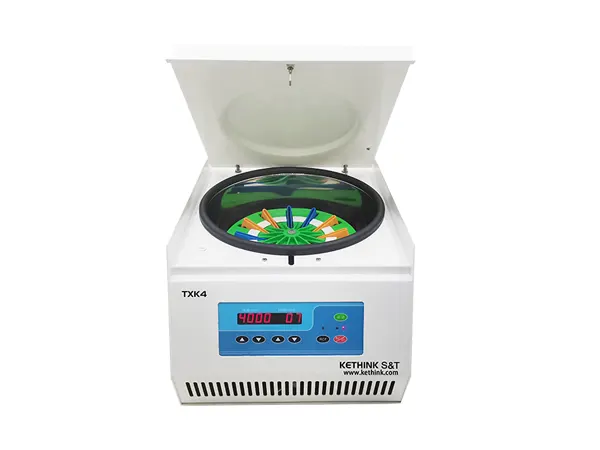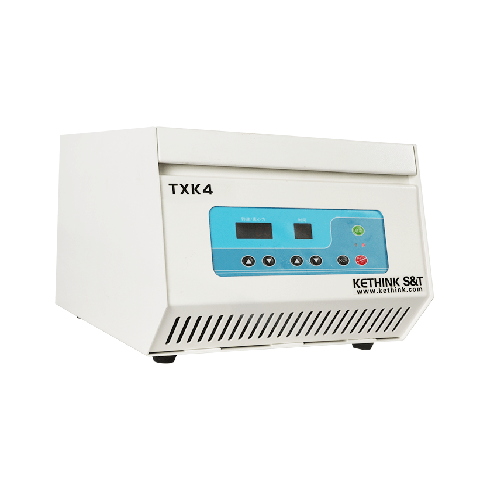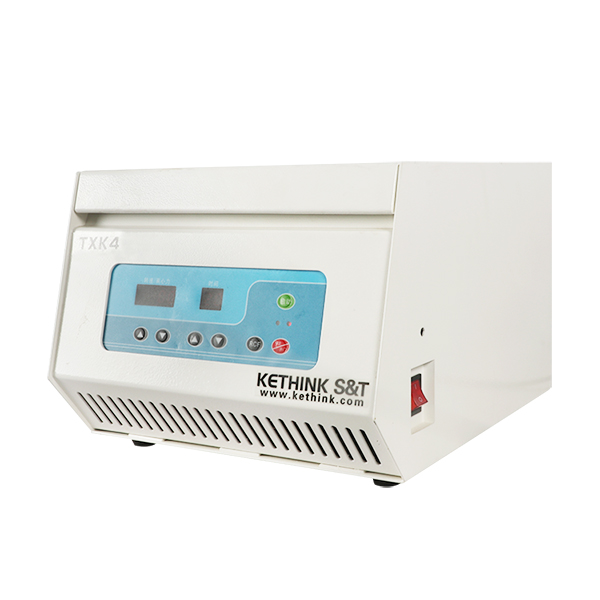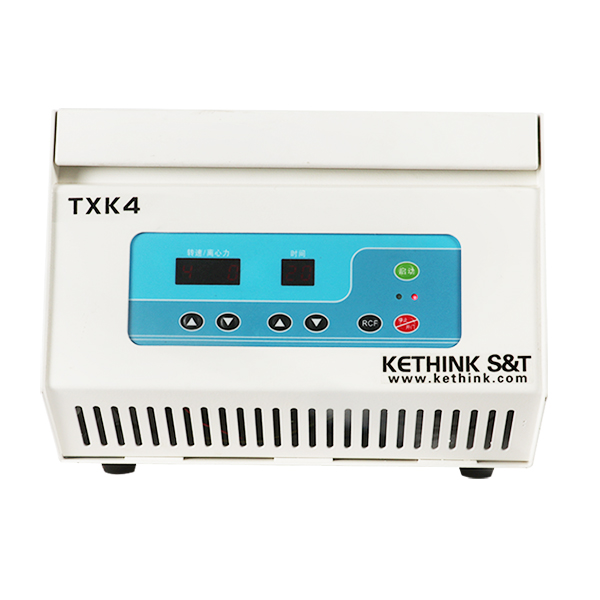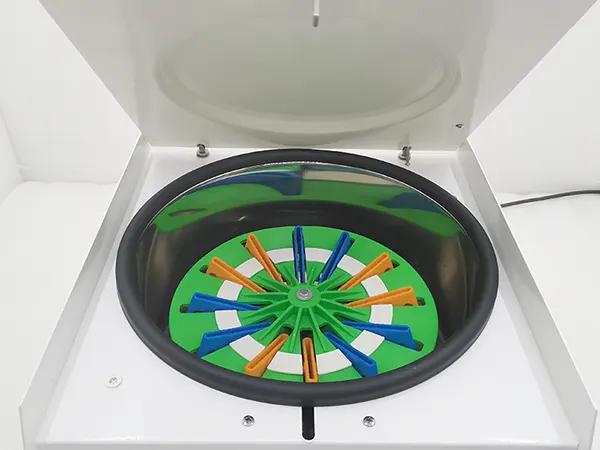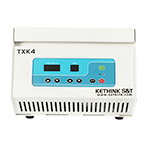Blood bank gel card centrifuge
Due to standardized operation and sensitive test, micro column gel technology is widely used in blood serology, routine serum detection, red blood cell washing, microcolumn gel immunoassay experiments, etc.The KT-TXK4 blood gel card desktop low-speed centrifuge with 12/24 card rotor meets the batch standard operation requirements. The system adopts microcomputer control and automatic imbalance detection technology, simple operation and accurate detection results. It is a necessary instrument for experimental hematology for hospital & blood banks.
- Model: KT-TXK4
- Max Speed: 4000rpm
- Max RCF: 2240xg
- Max Capacity: 12/24 cards
- Speed Accuracy: ± 50rpm
- Timer Range: 1 – 99min
- Power: 200W AC 220V 50HZ 10A
- Noise: ≤55dB(A)
- Net Weight: 24Kg
- Device Dimension: 483*320*265mm (L*W*H)
Gel Card Centrifuge Rotors(customized product available)
| Rotor Type | Max Volume (ml) | Max Speed (rpm) | Max RCF(g) |
| Swing Rotor | 12 cards | 4000 | 1700 |
| Swing Rotor | 24 cards | 4000 | 2120 |
What is gel card centrifuge?
A gel card centrifuge is also called “blood type card centrifuge” or “blood group centrifuge”, because it is specially designed with rotors to suit gel microcolumn blood type cards. It is used in blood serology, blood type identification tests before crossmatching, erythrocyte washing, microcolumn agglutination, immunology, and other tests.
Features
- Brushless motor to make sure free maintenance, no powder pollution, microcomputer control and digital display the time, speed, and RCF to let the operation easily.
- Special centrifugation technical to different reagents according to the requirement.
- 10 Regular centrifugation programs, choose by yourself
- Electrical lid lock, over speed, and imbalance protection.
Application
- ABO blood type test test
- Rh blood group antigen test
- Irregular antibody screening
- Cross match
- HDN detection
- Platelet antibody screening
- Platelet crossmatch
Micro Column Gel Technology
In 1990, Frenchman Y. Lapierre published an article introducing a new immunological detection technology: combining antigen-antibody reaction with gel molecular sieve technology, that is, microcolumn gel immunoassay. The essence of this technology is the hemagglutination test, that is, the red blood cell antigen antibody undergoes a macroscopic immune agglutination reaction in the gel medium in the micro-column cavity.
The microcolumn gel immunoassay technology stands out from the traditional blood group serology routine detection. It is adopted by advanced countries in the world for its simple operation, clear results, and rapid recognizability, replacing the traditional blood coagulation test that has been applied for 100 years. Microcolumn gel immunoassay technology requires a microcolumn gel card, and the detection of microcolumn gel card must have a centrifuge equipped with a dedicated card holder.
Blood Gel Card Centrifuge Principle
The essence of the microcolumn gel immunoreaction is the red blood cell agglutination test, which can also be called microcolumn gel heamagglutination assay (MGHA). In the microcolumn gel tube, the red blood cells and the corresponding antibody combine to form a red blood cell clump. By low-speed centrifugation, the clot is located on the surface of the gel or in the gel: the red blood cells that are not bound to the antibody sink to the bottom of the gel (the tip of the tube bottom).
Micro Column Gel Technology Advantages
- Simple operation, no washing, no confirmation test for negative results, which solves the problem that the Coombs test cannot be routinely applied in clinical practice due to complicated procedures and time-consuming reasons.
- Make the incomplete antibody detection theory “gold standard” become the clinical “gold standard”.
- The results can be obtained by centrifuging multiple specimens at one time (12/24 tubes), which is conducive to the detection of a large number of clinical specimens.
- In addition, it has the advantages of accuracy, sensitivity, less specimen consumption, long results storage time, easy standardization, and safer operation.
Micro Column Gel Technology Disadvantages
- Slightly higher cost than traditional methods.
Paternity Testing Method
ABO blood type positive and negative type and RhD blood type test card, used for the detection of human ABO antigen positive and negative type and RhD antigen. Column agglutination method (microcolumn gel method) is one of the commonly used methods for blood group identification. It is an immunological method in which red blood cell antigens and corresponding antibodies agglutinate in a microcolumn gel medium. The operation of this method is standardized, and the sample is quantified, which can ensure the accuracy of the results.
Steps:
- 1. Blood sample collection: (Note: samples containing abnormally increased serum protein should be used after sufficient washing of red blood cells.)
- 2. Blood sample processing:
- 1)Centrifuge the anticoagulated whole blood sample at 900~1000g centrifugal force for 5 minutes, the lower layer is the concentrated packed red blood cells with a concentration of about 80%. Carefully absorb the upper plasma in another test tube, which can be used directly in the experiment.
- 2)Dilute the packed red blood cells to be tested: Take 8-10μl packed red blood cells, add 1ml red blood cell diluent, the appearance should be uniform light red, no flocs and blood clots.
- 3)Dilution of red blood cells:Take 8-10μl packed red blood cells, add 1ml red blood cell diluent, the appearance should be uniform light red, no flocs and blood clots.

- 3. Blood type card operation:
- 1) Mark the prepared micro-living gel reagent card.
- 2) Add the prepared red blood cell suspension to the first to fourth tubes respectively, and add the diluted inverted red blood cells to the fifth to sixth tubes.
- 3) Immediately centrifuge for 5 minutes (900rpm for 2 minutes, 1500rpm for 3 minutes) in a blood type card centrifuge, and take out the result of the naked eye judgment.
